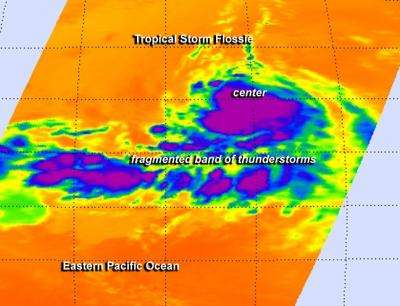NASA's infrared data shows Tropical Storm Flossie's strength

Tropical Storm Flossie formed in the Eastern Pacific Ocean and strengthened quickly on July 25. NASA's Aqua satellite passed over Flossie and captured an infrared look at the storm and saw a large area of powerful thunderstorms around its center and south of the center.
The Atmospheric Infrared Sounder or AIRS instrument flies aboard NASA's Aqua satellite. AIRS captured an infrared image of Tropical Storm Flossie on July 25 at 10:05 UTC (6:05 a.m. EDT). Infrared data helps determine temperature, such as the cloud top and sea surface temperatures. AIRS data revealed that Flossie's strongest storms and heaviest rains were around its center and in a fragmented band of thunderstorms south of the center. Those areas had cloud top temperatures near -63F/-52C, indicating very high thunderstorms.
The National Hurricane Center or NHC noted that at 8 a.m. PDT (11 a.m. EDT) the center of Tropical Storm Flossie was near latitude 15.3 north and longitude 125.6 west. Flossie is moving toward the west near 16 mph (26 kph) and is expected to continue in that direction for the next couple of days. Flossie's maximum sustained winds remain near 40 mph (65 kph) and NHC expects some strengthening during the next 48 hours. The estimated minimum central pressure is 1003 millibars.
The NHC's current forecast track takes Flossie toward Hawaii as a depression by Tuesday, July 30.
Provided by NASA's Goddard Space Flight Center





















